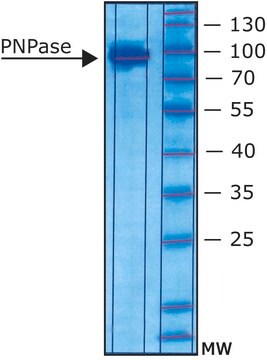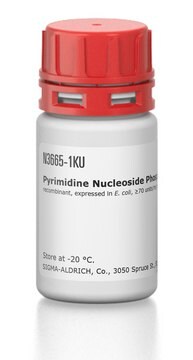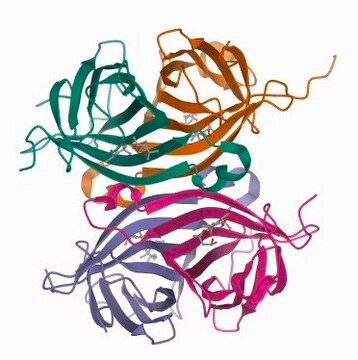N1290
Polynucleotide phosphorylase human
Sinónimos:
Polyribonucleotide nucleotidyltransferase
Iniciar sesiónpara Ver la Fijación de precios por contrato y de la organización
About This Item
Número MDL:
Código UNSPSC:
12352204
NACRES:
NA.54
Productos recomendados
recombinante
expressed in E. coli
Formulario
solution
enzyme activity
≥20 units/mg protein
mol peso
~90 kDa
concentración
400-600 μg/mL protein
Condiciones de envío
dry ice
temp. de almacenamiento
−70°C
Acciones bioquímicas o fisiológicas
Polynucleotide phosphorylase (PNPase) is a bifunctional enzyme with a phosphorolytic 3′ to 5′ exoribonuclease activity and a 3′-terminal oligonucleotide polymerase activity. It is also involved in mRNA processing and degradation in bacteria, plants, and humans.
Forma física
supplied as a solution in 20 mM HEPES buffer, pH 7.9, with 0.1 mM EDTA, 2 mM DTT, 12.5 mM MgCl2, ~130 mM KCl, and 20% (w/v) glycerol.
Código de clase de almacenamiento
12 - Non Combustible Liquids
Clase de riesgo para el agua (WGK)
WGK 1
Punto de inflamabilidad (°F)
Not applicable
Punto de inflamabilidad (°C)
Not applicable
Elija entre una de las versiones más recientes:
Certificados de análisis (COA)
Lot/Batch Number
¿No ve la versión correcta?
Si necesita una versión concreta, puede buscar un certificado específico por el número de lote.
¿Ya tiene este producto?
Encuentre la documentación para los productos que ha comprado recientemente en la Biblioteca de documentos.
Lukasz S Borowski et al.
Biochimica et biophysica acta, 1797(6-7), 1066-1070 (2010-02-02)
Protein complexes responsible for RNA degradation play important role in three key aspects of RNA metabolism: they control stability of physiologically functional transcripts, remove the unnecessary RNA processing intermediates and destroy aberrantly formed RNAs. In mitochondria the post-transcriptional events seem
Victoria Portnoy et al.
RNA (New York, N.Y.), 14(2), 297-309 (2007-12-18)
PNPase is a major exoribonuclease that plays an important role in the degradation, processing, and polyadenylation of RNA in prokaryotes and organelles. This phosphorolytic processive enzyme uses inorganic phosphate and nucleotide diphosphate for degradation and polymerization activities, respectively. Its structure
Hsiao-Wen Chen et al.
Molecular and cellular biology, 26(22), 8475-8487 (2006-09-13)
We recently identified polynucleotide phosphorylase (PNPase) as a potential binding partner for the TCL1 oncoprotein. Mammalian PNPase exhibits exoribonuclease and poly(A) polymerase activities, and PNPase overexpression inhibits cell growth, induces apoptosis, and stimulates proinflammatory cytokine production. A physiologic connection for
Takashi Nagaike et al.
The Journal of biological chemistry, 280(20), 19721-19727 (2005-03-17)
Mammalian mitochondrial (mt) mRNAs have short poly(A) tails at their 3' termini that are post-transcriptionally synthesized by mt poly(A) polymerase (PAP). The polyadenylation of mt mRNAs is known to be a key process needed to create UAA stop codons that
Magdalena Leszczyniecka et al.
Proceedings of the National Academy of Sciences of the United States of America, 99(26), 16636-16641 (2002-12-11)
Terminal differentiation and cellular senescence display common properties including irreversible growth arrest. To define the molecular and ultimately the biochemical basis of the complex physiological changes associated with terminal differentiation and senescence, an overlapping-pathway screen was used to identify genes
Nuestro equipo de científicos tiene experiencia en todas las áreas de investigación: Ciencias de la vida, Ciencia de los materiales, Síntesis química, Cromatografía, Analítica y muchas otras.
Póngase en contacto con el Servicio técnico







